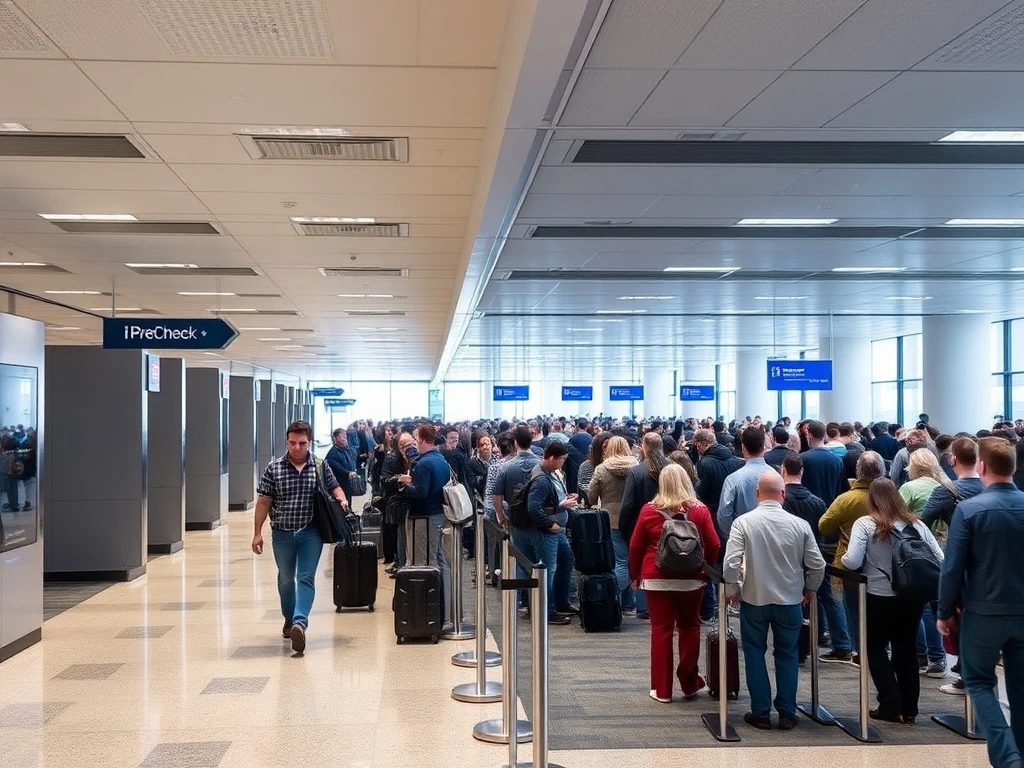In today’s fast-paced world, efficiency is paramount. For business travelers and entrepreneurs, time truly equals money. The question of optimizing every minute, especially during travel, often arises. Many seasoned flyers question the ongoing value of expedited airport screening programs. However, recent developments suggest a renewed focus on the benefits of TSA PreCheck. This program continues to offer surprising value, despite growing enrollment numbers. Understanding its true benefits can transform your travel experience. It can even provide a competitive edge in a demanding professional landscape.
Understanding TSA PreCheck: A Core Overview
Firstly, let us define TSA PreCheck. It is a U.S. government program. It allows pre-approved travelers to enjoy expedited security screening. This means no removing shoes, belts, or light jackets. Laptops and liquids also stay in carry-on bags. The Transportation Security Administration (TSA) manages this program. It aims to streamline the security process for low-risk passengers. This helps security personnel focus on higher-risk individuals. Consequently, airport lines move faster. Travelers experience less hassle.
Enrollment involves a simple application process. Applicants must complete an online form. Then, they schedule an in-person appointment. This appointment includes a background check and fingerprinting. Most importantly, it verifies identity and ensures eligibility. Once approved, travelers receive a Known Traveler Number (KTN). This KTN is then added to flight reservations. Therefore, the PreCheck designation appears on boarding passes. This allows access to the dedicated security lanes. The entire process typically takes a few weeks. It provides five years of benefits for a fee.
The Evolving Landscape: Why Travelers Question TSA PreCheck’s Value
Over time, the popularity of TSA PreCheck has grown significantly. Millions of travelers now hold a KTN. This success, however, has led to some unintended consequences. In certain airports, at peak times, PreCheck lines can appear long. This development makes some travelers question the program’s original promise. They wonder if the time savings are still significant. Some report general security lines moving faster than PreCheck lines on occasion. This happens due to various operational factors. For instance, sometimes a single lane serves both groups. Or, a regular line might open more quickly.
Furthermore, the initial investment for TSA PreCheck is a consideration. While modest, it is still a cost. Travelers evaluate this against perceived benefits. They weigh the fee against potential time savings. For infrequent flyers, the value proposition might seem less clear. They might not experience enough travel to justify the cost. Moreover, some travelers are unaware of the full range of benefits. They only focus on the line length. This narrow view can lead to undervaluation of the program. However, a deeper look reveals more advantages.
Unveiling the Surprising Deal: Beyond Shorter Lines
The true “surprising deal” of TSA PreCheck extends beyond just line speed. It offers a consistent, predictable security experience. This consistency is invaluable for frequent travelers. Firstly, it significantly reduces travel stress. Knowing you will not need to unpack your bag at security is a major relief. This predictability helps manage tight connections. It also allows for more relaxed airport arrival times. Consequently, travelers can optimize their pre-flight schedule. They can use this saved time for work or relaxation.
Secondly, many credit cards and loyalty programs now cover the TSA PreCheck application fee. This effectively makes the program free for eligible cardholders. Travelers should check their existing credit card benefits. Many premium travel cards offer a statement credit for enrollment fees. This benefit significantly enhances the program’s value. It transforms a perceived cost into a complimentary perk. Therefore, for many, the financial barrier disappears entirely. This makes the program an undeniable value proposition. Furthermore, some employers reimburse the fee. This also boosts its appeal for business travel.
Thirdly, TSA PreCheck benefits extend to family members. Children aged 12 and under can accompany an enrolled parent or guardian in the PreCheck lane. This simplifies family travel immensely. Parents avoid the hassle of getting children to remove shoes. They also skip the need to unpack bags for toys or snacks. This benefit alone can make family airport experiences much smoother. It reduces pre-flight chaos. This contributes to a more pleasant start to any trip. The overall ease of passage is a significant, often overlooked, benefit.
Maximizing Your PreCheck Experience: Practical Tips for Travelers
To fully leverage the benefits of TSA PreCheck, travelers can adopt several strategies. Always ensure your Known Traveler Number (KTN) is correctly added to your flight reservations. This is crucial for receiving the PreCheck indicator on your boarding pass. Without it, you cannot access the dedicated lane. Double-check this detail during booking. Also, verify it again before heading to the airport. Many airlines allow you to add your KTN to your frequent flyer profile. This automatically applies it to future bookings. This saves time and prevents errors.
Furthermore, arrive at the airport with sufficient time. While TSA PreCheck often saves time, unexpected delays can still occur. These might include technology glitches or staffing issues. A relaxed approach helps manage any unforeseen circumstances. Moreover, remain aware of airport specific conditions. Some smaller airports might not have dedicated PreCheck lanes open at all times. Always check airport information before departure. This helps set realistic expectations. It also ensures a smoother journey.
Lastly, understand the rules of the PreCheck lane. While less restrictive, some rules still apply. For instance, large liquids (over 3-1-1 rule) are not allowed. Also, prohibited items remain prohibited. Following these guidelines ensures a quick passage. It prevents any delays at the checkpoint. By being prepared, travelers can consistently enjoy the expedited process. This maximizes the program’s efficiency for every trip.
Comparing Expedited Programs: TSA PreCheck vs. Global Entry and CLEAR
Travelers often consider other expedited screening programs alongside TSA PreCheck. Global Entry is another popular option. It includes all the benefits of PreCheck. Additionally, Global Entry provides expedited customs processing upon re-entry into the United States. This is particularly beneficial for international travelers. The application process for Global Entry is more rigorous. It includes an in-person interview at a Customs and Border Protection (CBP) enrollment center. The fee is slightly higher, but it also lasts for five years. For frequent international flyers, Global Entry offers superior value.
CLEAR is a third program. It focuses on identity verification. CLEAR members bypass the initial ID check line. They go directly to the physical screening area. This means they skip the queue for showing their ID to a TSA agent. However, CLEAR does not include the benefits of PreCheck. Members still need to remove shoes, liquids, and laptops. Many travelers combine CLEAR with TSA PreCheck. This combination offers the fastest possible path through security. They skip both the ID check line and the traditional screening requirements. CLEAR is generally more expensive. Its annual fee is significantly higher than PreCheck or Global Entry. Therefore, it appeals most to very frequent travelers seeking ultimate speed.
Choosing the right program depends on individual travel habits. For domestic travelers, TSA PreCheck remains an excellent, cost-effective choice. International travelers will find Global Entry more comprehensive. Those prioritizing maximum speed at any cost might consider adding CLEAR. Each program offers distinct advantages. Understanding these differences helps travelers make an informed decision. This ensures they select the best fit for their specific needs.
The Enduring Value of TSA PreCheck for Modern Travelers
In conclusion, despite evolving airport dynamics, the enduring value of TSA PreCheck remains clear. It offers more than just potentially shorter lines. It provides a consistent, less stressful, and more predictable security experience. This predictability allows travelers to better manage their time. For business professionals, this means more productive hours. For families, it means less pre-flight anxiety. The availability of fee reimbursement through credit cards further solidifies its appeal. This makes it a surprisingly accessible perk for many.
Moreover, the program’s focus on efficiency aligns with modern travel demands. As air travel continues to grow, expedited screening programs will become even more critical. TSA PreCheck helps maintain order and speed at checkpoints. It contributes to a smoother overall airport operation. Therefore, for those who value time, convenience, and a calmer start to their journeys, TSA PreCheck continues to be a worthwhile investment. It truly unlocks surprising value for smart travelers navigating today’s complex travel landscape.
Frequently Asked Questions About TSA PreCheck
1. What is TSA PreCheck and how does it work?
TSA PreCheck is a U.S. government program. It allows pre-approved travelers to go through expedited airport security. Members keep on shoes, belts, and light jackets. Laptops and liquids stay in carry-on bags. You apply online, complete an in-person appointment, and receive a Known Traveler Number (KTN) to use when booking flights.
2. Is TSA PreCheck still worth it with longer lines sometimes?
Yes, its value extends beyond just line length. It offers a consistent, predictable, and less stressful security experience. Many credit cards also reimburse the application fee, making it free for eligible cardholders. This significantly boosts its overall value for travelers.
3. How long does TSA PreCheck approval take?
After your in-person appointment, most applicants receive their Known Traveler Number (KTN) within 3-5 days. Some applications can take up to 60 days. The KTN is valid for five years.
4. Can my family use TSA PreCheck if I have it?
Children aged 12 and under can accompany an enrolled parent or guardian in the TSA PreCheck lane. Travelers 13 and older must have their own KTN to use the lane. This policy makes family travel much simpler and faster.
5. What is the difference between TSA PreCheck and Global Entry?
TSA PreCheck provides expedited airport security for domestic flights. Global Entry includes all PreCheck benefits plus expedited customs processing for international arrivals. Global Entry is generally recommended for frequent international travelers, while PreCheck suits domestic flyers best.


















